List of sex symbols

A sex symbol is a celebrity figure or fictional character who is widely regarded as sexually attractive. Sex symbols are generally found among popular actors, musicians, supermodels, teen idols and athletes. The term was first used in the mid-1950s in relation to the popularity of certain film stars, including Marilyn Monroe, Brigitte Bardot, Marlon Brando, James Dean, and Raquel Welch.[2]
The following sections document the eras in which each listed individual became recognized as a sex symbol.
Before 1900[edit]
| Person | Year of birth |
Details |
|---|---|---|
 Mary Robinson |
1757 | The Times's Deirdre Fernand said Mary Robinson was "the feminist sex symbol who scandalised England" by having affairs with the man who would become King George IV of the United Kingdom.[3] |
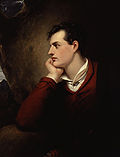 Lord Byron |
1788 | The scholar John Lauritsen wrote in The Gay & Lesbian Review Worldwide that Lord Byron was "the reigning male sex symbol of the early 19th century".[4] His persona was nurtured by his "flamboyant lifestyle", his "sporadic personal beauty" where he oscillated between corpulence and gauntness, and his relationships with women.[4] Author Mo Rocca said that Lord Byron turned into a sex symbol in 1811 after he authored the lengthy poem Childe Harold's Pilgrimage that featured an "intense brooding hero". |
 Franz Liszt |
1811 | Ivan Hewett called Liszt "the greatest sex symbol classical music has ever produced", which Hewett said "shows that looks are hardly the most important thing". As a youth, Liszt was very attractive, according to Hewett. Upon walking on the platform and soundlessly taking off his gloves, the women "swooned" over him. Although he had a wart on his face three decades later, women were still interested in him including one who pretended to be a male to travel through Europe following him.[5] Music professor Craig M. Wright found Liszt to be "the musical sex symbol of the Romantic era" who was "handsome, supremely talented, and equally self-confident".[6] |
 Lola Montez |
1821 | Irving Wallace and his coauthors wrote that Lola Montez was "the reigning sex symbol of her day" because her sensational theater acting captivated men and astonished women.[7] The scholar Mary C. Henderson said Montez was "the female sex symbol of her age" who "carved a notorious reputation on two continents" and had a short stint in theater performing the "Spider Dance". |
 Adah Isaacs Menken |
1835 | Scholar Renée M. Sentilles noted that Menken was "a sex symbol who played male roles on stage".[8] Author Justin Martin called Menken "one of the great sex symbols of the nineteenth century".[9] The Central States Speech Journal said Menken, who became "a sex symbol in a time of Victorian prudery", was "the Marilyn Monroe of her day". Menken was similar to Monroe in that she was "known more for her voluptuousness than for her acting ability".[10] |
 Sarah Bernhardt |
1844 | The historian Judith Bowers wrote that Sarah Bernhardt was "the greatest female sex symbol the stage had ever known".[11] In his autobiography, the journalist Maurice de Waleffe said that around 1900, he was in his Sofia hotel room adjacent to a French couple who were on their honeymoon.[12] The woman said, "Make love to me as if I were Sarah Bernhardt!"[12] University of East Anglia reader Stephen Wilson commented that Waleffe's account demonstrated how Bernhardt had turned into a "popular sex symbol".[12] |
 Lillie Langtry |
1853 | Critic Rosamund Marriott Watson, while writing under the pseudonym Graham R. Tomson, said that George du Maurier's illustrations of Lillie Langtry produced a "new standard of beauty", which was "modernist aesthetics meets sex symbol" according to scholar Paul L. Fortunato.[13] Langtry exercised every day, giving her a strong figure. |
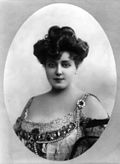 Lillian Russell |
1860/1861 | Scholar Brett Silverstein said Lillian Russell "may have been the most popular sex symbol this nation has ever known". |
1900s–1920s[edit]
The early 20th century saw the emergence of stars of silent films.
| Person | Year of birth |
Details |
|---|---|---|
 Mata Hari |
1876 | Mata Hari was a Dutch exotic dancer who performed at times partially nude. The author Joseph Bernard Hutton wrote in 1971 that said she despite her not measuring up to present-day standards of attractiveness, in her era she was "a glamorous sex symbol who excited the imagination of men of all nationalities". |
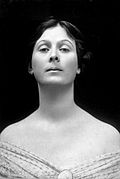 Isadora Duncan |
1877/1878 | The biographer Axel Madsen called Isadora Duncan the "sex symbol of intellectuals", whose art enticed artists, authors, and rich benefactors.[14] |
 John Barrymore |
1882 | A contemporary writer, Elinor Glyn, thought that he and Clara Bow were the only ones with a "sexual magnetism" Glyn called "It".[15] |
 Douglas Fairbanks |
1883 | The biographer Eve Golden said that Fairbanks' sex symbol status "easily rivale[d]" that of the actors John Gilbert and Rudolph Valentino. The 1920 film The Mark of Zorro and the 1922 film Douglas Fairbanks in Robin Hood helped establish his status as a sex symbol.[16] |
 Theda Bara |
1885 | Author Mary Flanagan wrote that Theda Bara was the "first cinematic sex symbol" whose "success as a sex symbol stems from her construction as a persona without a fixed personal history". Despite her being nearly 30 and having a background, for every one of her movie parts, Fox Film devised for her a new fake background related to the movie. Bara starred in the 1915 film A Fool There Was where she played a vampire, which resulted in the nickname "The Vamp". Bara's depiction in the film influenced women to choose "a new exotic look" that included "bobbed hair, thick bangs, pale facial makeup, dark red lips, and eyes accented with kohl liner and thick mascara". She maintained very long fingernails that had "sharply pointed ends". As "vampish women were viewed as mysterious, aggressive, and seductive", author Victoria Sherrow said Bara was "the movies' first sex symbol".[17] |
 Mae West |
1893 | American actress, singer, playwright, screenwriter and comedian[18] |
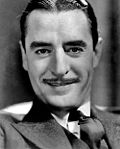 John Gilbert |
1897 | The biographer Eve Golden called Gilbert "the screen's hottest hearthrob, the top male sex symbol of the late 1920s and one of MGM's box-office handchamps". She found him "handsome, mercurial, and very talented".[19] Jeanine Basinger, a film historian, said Gilbert was "the male equivalent of the female sex symbol" who influenced women to have amorous thoughts about him. Gilbert was able to portray a "handsome, passionate, somewhat brooding man" who simultaneously was also genuine and approachable, not someone who would be unreachable.[20] |
 Joan Crawford |
1904/1908 | Joan Crawford was one of the final flappers who were sex symbols. The author Scott Siegel said that she "soon crossed the fine line from sex symbol to glamour queen".[21] The Mercury News said she was "MGM's reigning sex symbol" in the 1930s.[22] |
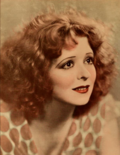 Clara Bow |
1905 | Clara Bow was the first cinematic sex symbol[23][24] History professor Patrick Huber called Bow "the greatest sex symbol and the biggest Hollywood star of the late 1920s".[25] Her portrayal of flappers, particularly her depiction of the alluring clerk in the 1927 film It, transformed Bow into a sex symbol who received the nickname "It Girl".[25] The nickname "It Girl" was used instead of "sex symbol" since the latter terminology would have been deemed obscene in Bow's era.[26] Frequently paid below-market wages and fighting to be given respect, she believed herself to be stuck in her sex symbol role, saying, "A sex symbol is a heavy load to carry when one is tired, hurt, and bewildered".[27] |
1930s–1940s[edit]
With the transition to sound movies, the Golden Age of Hollywood promoted a new generation of glamorous stars. The war effort ushered in celebrity status for pin-up models, and movie stars were sent abroad to entertain troops.
| Person | Year of birth |
Details |
|---|---|---|
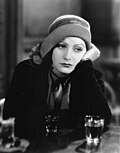 Greta Garbo |
1905 | Greta Garbo was recruited from Sweden to the United States as a "glamour sex symbol".[citation needed] |
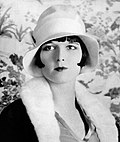 Louise Brooks |
1906 | Louise Brooks, one of the most acclaimed performers during the silent film time period, was a sex symbol who wore the bob cut.[28] By 1928, the year she divorced film director A. Edward Sutherland, Brooks had experienced a swift ascent to stardom that made her a sex symbol.[29] Film critic John Anderson called her "a sex symbol of disturbing volatility", while Kenneth Tynan said she was "the most seductive, sexual image of Woman ever committed to celluloid".[30] |
1950s–1960s[edit]
In the post-war era, the term sex symbol gained general acceptance. The sexual liberation of the 1960s allowed further free expression of desire and sexuality in popular culture.
| Person | Year of birth |
Details |
|---|---|---|
 Bettie Page |
1923 | American pinup model[31] |
 Marilyn Monroe |
1926 | American actress[32] |
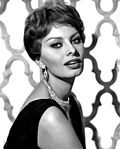 Sophia Loren |
1934 | Italian actress[33] |
 Brigitte Bardot |
1934 | French actress[34] |
 Raquel Welch |
1940 | A publicity still of Loana the Fair One in One Million Years B.C., portrayed by Raquel Welch wearing a fur bikini, became a best-selling poster and turned her into an instant pin-up girl[35] and sex symbol.[36][37][38] |
See also[edit]
Some use of "" in your query was not closed by a matching "".Some use of "" in your query was not closed by a matching "".
References[edit]
Citations[edit]
- ↑ "BBC World Service - Witness, The Death of Marilyn Monroe". BBC. Retrieved 30 December 2014.
- ↑ Flexner & Soukhanov (1997), p. 373
- ↑ Fernand, Deidre (31 October 2004). "Mary, Queen of shocks". The Times. Retrieved 30 June 2020.
- ↑ 4.0 4.1 Lauritsen, John (Jan–Feb 2011). "Lord Byron's Taste in Men". The Gay & Lesbian Review Worldwide. Vol. 18 no. 1. Archived from the original on 25 January 2016. Retrieved 4 January 2016. Unknown parameter
|url-status=ignored (help) - ↑ Hewett, Ivan (21 April 2005). "Who needs this when the classics are already bursting with sex?". The Daily Telegraph. Archived from the original on 30 June 2020. Retrieved 30 June 2020.
- ↑ Wright (2008), p. 283
- ↑ Wallace et al. (2008), p. 152
- ↑ Sentilles (2003), p. 3
- ↑ Downing, Ben (5 September 2014). "Book Review: 'Rebel Souls' by Justin Martin". The Wall Street Journal. Archived from the original on 30 June 2020. Retrieved 30 June 2020.
- ↑ Ritter, Charles C. (1963). "The Menken in Mephis". The Central States Speech Journal. 14. p. 92. Retrieved 30 June 2020.
- ↑ Bowers (2007), p. 54
- ↑ 12.0 12.1 12.2 Wilson (1982), p. 593
- ↑ Fortunato, Paul L. (Summer 2007). "Wildean Philosophy with a Needle and Thread: Consumer Fashion at the Origins of Modernist Aesthetics". College Literature: A Journal of Critical Literary Studies. Johns Hopkins University Press. 34 (3). doi:10.1353/lit.2007.0032. Retrieved 30 June 2020.
- ↑ Madsen (2002), p. 45
- ↑ Furman & Furman (2000), p. 9
- ↑ Hudson (1987), p. 160
- ↑ Sherrow (2006), p. 49
- ↑ "Mae West, Hollywood's Sex Symbol, Dies". The Washington Post. November 23, 1980.
- ↑ Golden (2013), p. 1
- ↑ Basinger (2000), p. 371
- ↑ Siegel & Siegel (1990), p. 380
- ↑ Ross, Martha (13 September 2017). "Joan Crawford's crush on Bette Davis also fueled feud, Davis confidante says in new book". The Mercury News. Archived from the original on 2 July 2020. Retrieved 2 July 2020.
- ↑ Rausch (2003), p. 24
- ↑ Currell (2009), p. 112
- ↑ 25.0 25.1 Ciment (2015), p. 111
- ↑ Terry (2011), p. 30
- ↑ Harding (2012), p. 25
- ↑ Macnab, Geoffrey (4 June 2018). "Louise Brooks: The silent era It girl who became a film critic". The Independent. Archived from the original on 2 July 2020. Retrieved 2 July 2020.
- ↑ "Brooks, (Mary) Louise 1906-1985". Cengage. 20 June 2020. Archived from the original on 2 July 2020. Retrieved 2 July 2020 – via Encyclopedia.com.
- ↑ Anderson, John (21 November 2019). "'The Chaperone' Review: Traveling Companions With Baggage". The Wall Street Journal. Archived from the original on 2 July 2020. Retrieved 2 July 2020.
- ↑ Stephen Henderson (April 27, 1997). "Fans of Bettie Page, the 50's pinup queen, keep her image ageless". The New York Times.
- ↑ Nilsson, Jeff (1 June 2017). "9 Sex Symbols Before Marilyn Monroe". The Saturday Evening Post. Archived from the original on 30 June 2020. Retrieved 30 June 2020.
- ↑ Judy Klemesrud (September 22, 1977). "There's More to Sophia Loren Than Being a 'Sex Symbol'". The New York Times.
- ↑ Liz Smith (November 30, 2012). "Brigitte Bardot: The Sexiest of All Sex Symbols". HuffPost.
- ↑ Westcott, Kathryn (5 June 2006). "The Bikini: Not a brief affair". BBC News. Retrieved 17 September 2008.
- ↑ Bale, Miriam (10 February 2012). "The GQ&A: Raquel Welch". GQ. Retrieved 21 August 2013.
- ↑ Mansour, David (2005). From Abba to Zoom: a pop culture encyclopedia of the late 20th century. Andrews McMeel Publishing. p. 345. ISBN 978-0-7407-5118-9. Retrieved 28 August 2012. Search this book on

- ↑ Gayomali, Chris (5 July 2011). "Top 10 Bikinis in Pop Culture". Time. Archived from the original on 30 July 2017. Retrieved 30 July 2017. Unknown parameter
|url-status=ignored (help)
Bibliography[edit]
- Basinger, Jeanine (2000). Silent Stars. Hanover, New Hampshire: Wesleyan University Press. ISBN 0-8195-6451-6. Retrieved 2 July 2020. Search this book on

- Bowers, Judith (2007). Stan Laurel and Other Stars of the Panopticon: The Story of the Britannia Music Hall. Edinburgh: Birlinn. ISBN 978-1-84158-617-5. Retrieved 30 June 2020. Search this book on

- Ciment, James (2015) [2008]. Encyclopedia of the Jazz Age: From the End of World War I to the Great Crash. London: Routledge. ISBN 978-0-7656-8078-5. Retrieved 2 July 2020. Search this book on

- Currell, Susan (2009). American Culture in the 1920s. Edinburgh: Edinburgh University Press. ISBN 978-0-7486-2521-5. Retrieved 2 July 2020. Search this book on

- Golden, Eve (2013). John Gilbert: The Last of the Silent Film Stars. Lexington: University Press of Kentucky. ISBN 978-0-8131-4162-6. Retrieved 2 July 2020. Search this book on

- Flanagan, Mary (2007). "Mobile Identities, Digital Stars, and Post-Cinematic Selves". In Redmond, Sean; Holmes, Su. Stardom and Celebrity: A Reader. Los Angeles: SAGE Publishing. ISBN 978-1-4129-2320-0. Retrieved 30 June 2020. Search this book on

- Flexner, Stuart Berg; Soukhanov, Anne H. (1997). Speaking Freely: A Guided Tour of American English from Plymouth Rock to Silicon Valley. Oxford: Oxford University Press. ISBN 978-0-19-510692-3. Retrieved 30 June 2020. Search this book on

- Furman, Leah; Furman, Elina (2000). Happily Ever After: The Drew Barrymore Story. New York: Ballantine Books. ISBN 978-0-345-44051-8. Retrieved 2 July 2020. Search this book on

- Harding, Les (2012). They Knew Marilyn Monroe: Famous Persons in the Life of the Hollywood Icon. Jefferson, North Carolina: McFarland & Company. ISBN 978-0-7864-6637-5. Retrieved 2 July 2020. Search this book on

- Henderson, Mary C. (1989). Broadway Ballyhoo: The American Theater Seen in Posters, Photographs, Magazines, Caricatures, and Programs. New York: H.N. Abrams. ISBN 978-0-8109-1889-4. Retrieved 30 June 2020. Search this book on

- Hudson, Robert Vernon (1987). Mass Media: A Chronological Encyclopedia of Television, Radio, Motion Pictures, Magazines, Newspapers, and Books in the United States. New York: Garland Publishing. ISBN 978-0-8240-8695-4. Retrieved 2 July 2020. Search this book on

- Hutton, Joseph Bernard (1971). Women Spies. London: W. H. Allen & Co. ISBN 978-0-491-00417-6. Retrieved 2 July 2020. Search this book on

- Madsen, Axel (2002) [1995]. The Sewing Circle: Sappho's Leading Ladies. New York: Kensington Books. ISBN 0-7582-0101-X. Retrieved 2 July 2020. Search this book on

- Muray, Nickolas; Gallico, Paul (1967). The Revealing Eye: Personalities of the 1920's. New York: Atheneum Books. OCLC 566182. Retrieved 2 July 2020. Search this book on

- Rausch, Andrew J. (2003). Hollywood's All-Time Greatest Stars: A Quiz Book. New York: Citadel Press. ISBN 0-8065-2469-3. Retrieved 2 July 2020. Search this book on

- Rocca, Mo (2019). Mobituaries: Great Lives Worth Reliving. New York: Simon & Schuster. ISBN 978-1-5011-9762-8. Retrieved 30 June 2020. Search this book on

- Shmelter, Richard J. (2014). The USC Trojans Football Encyclopedia. Jefferson, North Carolina: McFarland & Company. ISBN 978-0-7864-6950-5. Retrieved 2 July 2020. Search this book on

- Sentilles, Renée M. (2003). Performing Menken: Adah Isaacs Menken and the Birth of American Celebrity. Cambridge: Cambridge University Press. ISBN 0-521-82070-7. Retrieved 30 June 2020. Search this book on

- Sherrow, Victoria (2006). Encyclopedia of Hair: A Cultural History. Westport, Connecticut: Greenwood Publishing Group. ISBN 0-313-33145-6. Retrieved 30 June 2020. Search this book on

- Siegel, Scott; Siegel, Barbara (1990). The Encyclopedia Of Hollywood. New York: Facts on File. pp. 379–382. ISBN 978-1-4381-3008-8. Retrieved 2 July 2020. Search this book on

- Silverstein, Brett (1995). The Cost of Competence: Why Inequality Causes Depression, Eating Disorders, and Illness in Women. Oxford: Oxford University Press. ISBN 978-0-19-506986-0. Retrieved 30 June 2020. Search this book on

- Terry, Keith (2011). Kearney's World Theater. Charleston, South Carolina: Arcadia Publishing. ISBN 978-0-7385-8325-9. Retrieved 2 July 2020. Search this book on

- Tyler, Parker (1994) [1974]. Sex in Films. New York: Citadel Press. ISBN 0-8065-1465-5. Retrieved 2 July 2020. Search this book on

- Wilson, Stephen (1982). Ideology and Experience: Antisemitism in France at the Time of the Dreyfus Affair. Rutherford: Fairleigh Dickinson University Press. ISBN 978-0-8386-3037-2. Retrieved 30 June 2020. Search this book on

- Wallace, Irving; Wallace, Amy; Wallechinsky, David; Wallace, Sylvia (2008) [1981]. "Sex Symbols". In Kempthorne, Elizebethe. The Intimate Sex Lives of Famous People. Port Townsend, Washington: Feral House. pp. 15–45. ISBN 978-1-932595-29-1. Retrieved 2020-06-22. Search this book on

- Wright, Craig (2008). Listening to Western Music. Belmont, California: Thomson Learning. ISBN 978-0-495-11627-1. Retrieved 30 June 2020. Search this book on

This article "List of sex symbols" is from Wikipedia. The list of its authors can be seen in its historical and/or the page Edithistory:List of sex symbols. Articles copied from Draft Namespace on Wikipedia could be seen on the Draft Namespace of Wikipedia and not main one.
